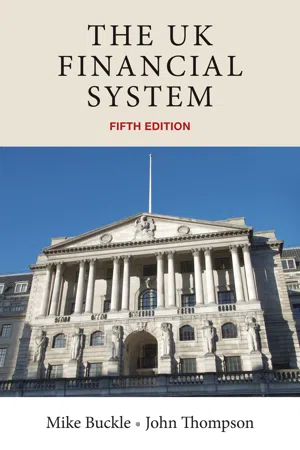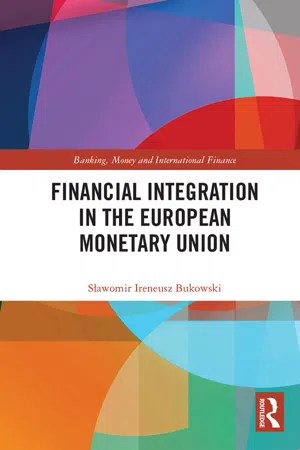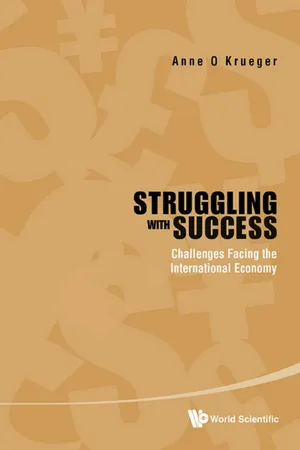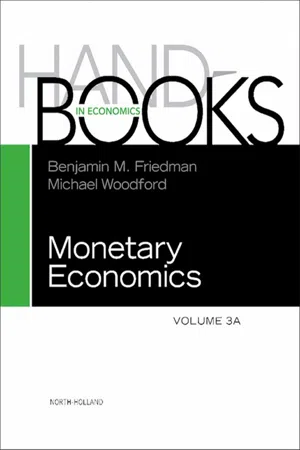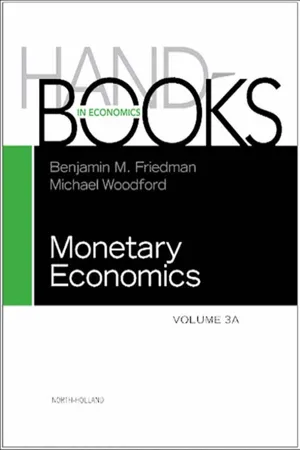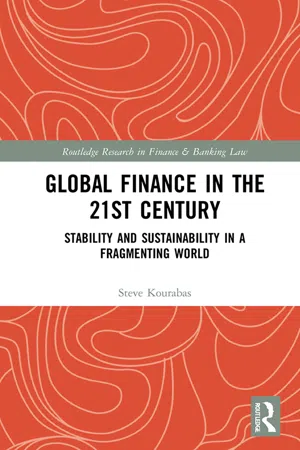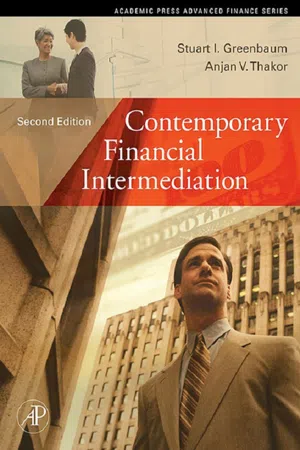Economics
Financial Intermediaries
Financial intermediaries are institutions that facilitate the flow of funds between savers and borrowers. They include banks, credit unions, and insurance companies, which collect funds from savers and then lend or invest these funds with borrowers. By providing a link between those with excess funds and those in need of funds, financial intermediaries play a crucial role in the efficient allocation of capital.
Written by Perlego with AI-assistance
Related key terms
8 Key excerpts on "Financial Intermediaries"
- eBook - ePub
The UK financial system
Theory and practice, fifth edition
- Mike Buckle, John Thompson(Authors)
- 2016(Publication Date)
- Manchester University Press(Publisher)
Part IInstitutionsPassage contains an image
Chapter 2Financial intermediation and recent developments in the UK financial system
2.1 IntroductionWe saw in chapter 1 that financial intermediation is one of the key functions of a financial system, connecting savers and borrowers and directing funds towards productive investments. In this chapter our primary aim is to describe the process of financial intermediation and in doing so we examine the arguments as to why we need financial institutions such as banks. Finally, we provide an overview of the tremendous changes that have taken place in the UK financial system over the last 20 years. This will provide a framework for the more specific discussion of events affecting financial institutions and markets which make up the remainder of this book.2.2 The nature of financial intermediationIn developed economies, decisions to invest (in capital projects) are often taken separately from decisions to save. There are some exceptions to this: for example, firms which do not distribute all profits as dividends but retain some to finance investment are both saving and investing. However, even when saving and investment are carried out by the same economic agent, the timing of the decisions will often be different. Saving may precede the investment as sufficient funds are accumulated, or the saving may follow the investment as debts used to finance it are paid off. However, it is a general feature of developed economies that a high proportion of saving is not used immediately by the saver but is made available to investors elsewhere. In chapter 1 - Maureen Burton, Reynold F. Nesiba, Bruce Brown(Authors)
- 2015(Publication Date)
- Routledge(Publisher)
All of these specialized intermediaries collect savings in the form of premium payments or contributions from plan participants. Each intermediary then uses the funds to purchase a variety of primary claims from net borrowers. Investment-type intermediaries (such as mutual funds and money market funds) pool the surplus funds of many small savers and invest them in financial markets, thereby offering the small savers greater opportunities to diversify than they would otherwise realize. Exhibit 1-4 highlights the various types of intermediaries. 1-4 Types of Financial Intermediaries Although our analysis covers intermediation in general, we pay particular attention to the role of depository institutions for several reasons. For one thing, depository institutions are by far the largest type of intermediary. They also are a central part of the process that determines the nation’s money supply. Because one of our main objectives is to understand the nature and role of money in our economy, we will focus on the behavior of depository institutions and the process of intermediation in which they engage. By examining how money is provided, what it costs to obtain money when we need it, and what we can earn when we have enough of it to lend out, we will learn much about how money and the financial system affect our economy. Recap When net lenders lend directly to net borrowers, direct finance occurs. When net lenders put their funds in Financial Intermediaries, which then lend to net borrowers, indirect finance occurs. Financial Intermediaries acquire the funds of net lenders by issuing claims on themselves. They use the funds to purchase the financial claims of net borrowers. The most important Financial Intermediaries are depository institutions that issue checkable deposits- S?awomir Ireneusz Bukowski(Author)
- 2019(Publication Date)
- Routledge(Publisher)
B. Scholtens and D. van Wensveen (2003, pp. 35–37) point to an essential characteristic of financial intermediation, namely creating added value for savers and investors comprised in financial instruments. This type of instrument cannot be created together or individually by savers and investors. This process of added value creation is intensified by competition between the existing financial institutions and those entering the market and introducing financial innovations. Financial institutions must continuously analyze the preferences of the financial market participants and translate these preferences into characteristics of new financial products. An important function of financial intermediation institutions is risk transformation. They create added value by creating financial instruments that absorb risk. In this way, the sector of financial intermediation institutions has evolved into the financial industry sector (see also Allen & Santomero, 1997, pp. 1461–1476; Merton & Bodie, 1995, pp. 1–27; Allen & Gale, 2001, pp. 127–149).As it was mentioned before, the relationship between the role and place in the market of financial intermediation institutions (banks, insurance societies, investment funds, etc.) and the market of financial instruments has changed. In the traditional system, direct customers of Financial Intermediaries – savings providers and borrowers – were households of lower income and assets and small and medium-size enterprises (SMEs).In the modern system formed as a result of the just-described phenomena related to knowledge-based economy, households and SMEs are customers of financial intermediation institutions that intermediate in investing resources obtained from them in the market of financial instruments (especially those listed in organized markets) and offering products based on exchange listed financial instruments. On the other hand, big companies benefit, to a large extent, from raising financial resources directly in organized capital markets (exchanges).It is a result of the just-described factors that financial intermediation institutions have become financial product providers creating added value. At the same time, such a state of affairs indicates the growing role of financial markets in economy and even the fact that they have become “the heart” of the financial system and market economy and the money and information “pump.”- eBook - ePub
Struggling with Success
Challenges Facing the International Economy
- Anne O Krueger(Author)
- 2012(Publication Date)
- WSPC(Publisher)
To assess risk appropriately, those who would potentially extend resources to investors must have information about the investor and the likely prospects that the proposed investment will be profitable. This includes an assessment of many aspects of risk, including not only the likelihood that the costs and expected revenues of the proposed project are realistic (and risks evaluated), but also of the creditworthiness of the investor, his ability to carry out the proposed activities, and so on. If each potential creditor had to assess these attributes, the “transactions” and “information” costs would be huge, and many savers would simply not be able to form the necessary judgments. Information provided by credit bureaus and other external assessment sources is very important. But so, too, is the experience of bankers and others who specialize in particular lines of activity, understand businesses, and make the appropriate judgments. In modern large-scale industry, the financial sector plays a key role in monitoring the performance of managers of large public companies. It is also crucial in assessing the prospects of start-ups, supporting initial public offerings (IPOs), providing advice as to financing techniques and alternatives, and much more.Financial Intermediaries enable savers to receive higher returns than they otherwise would. And investors are able to attract resources for prospectively high-return investments. And since industry specialists can professionally assess activities, Financial Intermediaries add value for both the investor and the saver, and contribute importantly to the growth of the real economy.Beyond that, however, Financial Intermediaries enable larger investments than would otherwise be possible; pooling the savings of many savers may be necessary to finance investments of economically efficient size; if investors had to raise the funds themselves, many investments would be uneconomically small. There is a wonderful quote from the eminent English analyst, Bagehot, that makes the point well2 :“We have entirely lost the idea that any undertaking likely to pay… can perish for want of money: A citizen.in Queen Elizabeth's time.would have thought it was no use inventing railways.for you would not have been able to collect the capital with which to make them. At this moment [1873] in colonies and all rude countries, there is no large sum of transferable money; there is no fund from which you can borrow, and out of which you can make immense works.” - eBook - ePub
- (Author)
- 2010(Publication Date)
- North Holland(Publisher)
In conventional models of monetary economics commonly used in central banks, the banking sector has not played a prominent role. The primary friction in such models is the price stickiness of goods and services. Financial Intermediaries do not play a role, except as a passive player that the central bank uses as a channel to implement monetary policy.However, Financial Intermediaries have been at the center of the global financial crisis that erupted in 2007. They have borne a large share of the credit losses from securitized sub-prime mortgages, even though securitization was intended to parcel out and disperse credit risk to investors who were better able to absorb losses. Credit losses and the associated financial distress have figured prominently in the commentary on the downturn in real economic activity that followed. These recent events suggest that Financial Intermediaries may be worthy of separate study to ascertain their role in economic fluctuations.The purpose of this chapter is to reconsider the role of Financial Intermediaries in monetary economics. In addressing the issue of financial factors in macroeconomics, we join a spate of recent research that has attempted to incorporate a financial sector in a New Keynesian DSGE model. Curdia and Woodford (2009) and Gertler and Karadi (2009) are recent examples. However, rather than phrasing the question of how financial “frictions” affect the real economy, we focus on the financial intermediary sector. We explore the hypothesis that the financial intermediary sector, far from being passive, is instead the engine that drives the boom-bust cycle. To explore this hypothesis, we propose a framework for study to address the following pair of questions. What are the channels through which Financial Intermediaries exert an influence on the real economy (if at all)? What are the implications for monetary policy?Banks and other Financial Intermediaries borrow in order to lend. Since the loans offered by banks tend to be of longer maturity than the liabilities that fund those loans, the term spread is indicative of the marginal profitability of an extra dollar of loans on intermediaries’ balance sheets. The net interest margin (NIM) of the bank is the difference between the total interest income on the asset side of its balance sheet and the interest expense on the liabilities side of its balance sheet. Whereas the term spread indicates the profitability of the marginal loan that is added to the balance sheet, the NIM is an average concept that applies to the stock of all loans and liabilities on the balance sheet. - eBook - ePub
- Benjamin M. Friedman, Michael Woodford(Authors)
- 2010(Publication Date)
- North Holland(Publisher)
In conventional models of monetary economics commonly used in central banks, the banking sector has not played a prominent role. The primary friction in such models is the price stickiness of goods and services. Financial Intermediaries do not play a role, except as a passive player that the central bank uses as a channel to implement monetary policy.However, Financial Intermediaries have been at the center of the global financial crisis that erupted in 2007. They have borne a large share of the credit losses from securitized subprime mortgages, even though securitization was intended to parcel out and disperse credit risk to investors who were better able to absorb losses. Credit losses and the associated financial distress have figured prominently in the commentary on the downturn in real economic activity that followed. These recent events suggest that Financial Intermediaries may be worthy of separate study to ascertain their role in economic fluctuations.The purpose of this chapter is to reconsider the role of Financial Intermediaries in monetary economics. In addressing the issue of financial factors in macroeconomics, we join a spate of recent research that has attempted to incorporate a financial sector in a New Keynesian DSGE model. Curdia and Woodford (2009) and Gertler and Karadi (2009) are recent examples. However, rather than phrasing the question of how financial “frictions” affect the real economy, we focus on the financial intermediary sector. We explore the hypothesis that the financial intermediary sector, far from being passive, is instead the engine that drives the boom-bust cycle. To explore this hypothesis, we propose a framework for study to address the following pair of questions. What are the channels through which Financial Intermediaries exert an influence on the real economy (if at all)? What are the implications for monetary policy?Banks and other Financial Intermediaries borrow in order to lend. Since the loans offered by banks tend to be of longer maturity than the liabilities that fund those loans, the term spread is indicative of the marginal profitability of an extra dollar of loans on intermediaries' balance sheets. The net interest margin (NIM) of the bank is the difference between the total interest income on the asset side of its balance sheet and the interest expense on the liabilities side of its balance sheet. Whereas the term spread indicates the profitability of the marginal loan that is added to the balance sheet, the NIM is an average concept that applies to the stock of all loans and liabilities on the balance sheet. - eBook - ePub
Global Finance in the 21st Century
Stability and Sustainability in a Fragmenting World
- Steve Kourabas(Author)
- 2021(Publication Date)
- Routledge(Publisher)
17This description of banking includes two important concepts: fractional reserve banking and the promise to return deposits. First, the distribution of savings to borrowers refers to what is commonly referred to as ‘fractional reserve banking .’ To understand the origins of fractional reserve banking we must travel back again to the Italian city-states during Renaissance and Middle Ages Europe and the role of moneychangers and moneylenders.Moneychangers exchanged coins during this period as minting money ceased to be a royal prerogative.18 They would sit behind their wooden tables (banci ) in small town squares across the major Italian city-states, such as the Campo San Giacomo di Rialto in Venice, where they would exchange various coins made of different metals and with different values to facilitate trade between merchants across European regions visiting to take part in trade fairs.19 Moneychangers also offered their vaults as a storage facility where merchants could store their coins for convenience and safe-keeping during fairs.20Moneylenders played an equally important role. As the need for money expanded to meet the demands of economic growth resulting from trade and the need to fund the wars and administrative needs of states and the Church, new techniques were devised to ensure that finance was available to those in need.21 Moneylenders took advantage of these financial needs to develop bills of exchange that reduced the reliance in economic transactions on coins made of rare precious metals.22 This facilitated the expansion of monetary supply and encouraged long-distance trade.23 Bills of exchange alleviated the problem of transferring large quantities of precious metals to complete economic transactions. They introduced the idea of documents demanding payment, drawn on coins held in vaults, to supplement the use of precious metals as currency.24 - eBook - ePub
- Stuart I. Greenbaum, Anjan V. Thakor(Authors)
- 2007(Publication Date)
- Academic Press(Publisher)
Glass-Steagall created two banking systems. Commercial bankers had subsidized deposits, but restricted asset choice. The investment banks were without deposit subsidies, but had great freedom on the asset side of the balance sheet, and protection from commercial bank competition in equity markets. This permitted the investment bankers to selectively attack the commercial banks’ niches of profitability, forcing them into ever riskier endeavors in order to justify the capital committed to commercial banking. The intricate and exquisitely contradictory relationship between commercial banks and investment banks is a product of American history. Their functions are substantially overlapping. The forms and instruments employed often differ only at a superficial level. Moreover, the investment banks are as much a creation of 1930s banking legislation as the commercial banks. With the dismantling of the Glass-Steagall Act and the passage of the Gramm-Leach-Bliley Act, this artificial separation between commercial and investment banking has been finally eliminated.The Role of the Government
To this point, we have sketched the major players in the world of financial intermediation. Probably the most important intermediaries to add to this list are the vast government enterprises that routinely provide a wide variety of financial services. These would include the Old Age, Survivors and Disability Insurance, Workers’ Compensation, Medicare, the housing agencies (Federal National Mortgage Corporations of FNMA or “Fannie Mae,” Federal Home Loan Mortgage Corporation or FHLMC or “Freddie Mac,” and the Government National Mortgage Association or GNMA or “Ginnie Mae”) Farm Credit Administration, Small Business Administration, Student Loan Marketing Association (or “Sally Mae”), and flood insurance programs of the Agriculture Department. And the list goes on!Annual payments to the federal government’s Old Age, Survivors, Disability Insurance, and Medicare programs are twice the assets of the largest commercial bank in the United States, and about one-sixth the assets of the entire commercial banking industry. Without doubt, the U.S. government is far and away the largest financial services provider in the country and arguably in the world.Financial Intermediaries on the Periphery
Gambling
Prominent on the periphery of the financial intermediation universe is the glamorous world of legal and illegal gambling. Some deny that gambling is a financial service, but this seems a quibble. The bookmaker is as much a broker as the trader of options and financial futures. The naysayers argue that gambling creates
Index pages curate the most relevant extracts from our library of academic textbooks. They’ve been created using an in-house natural language model (NLM), each adding context and meaning to key research topics.
